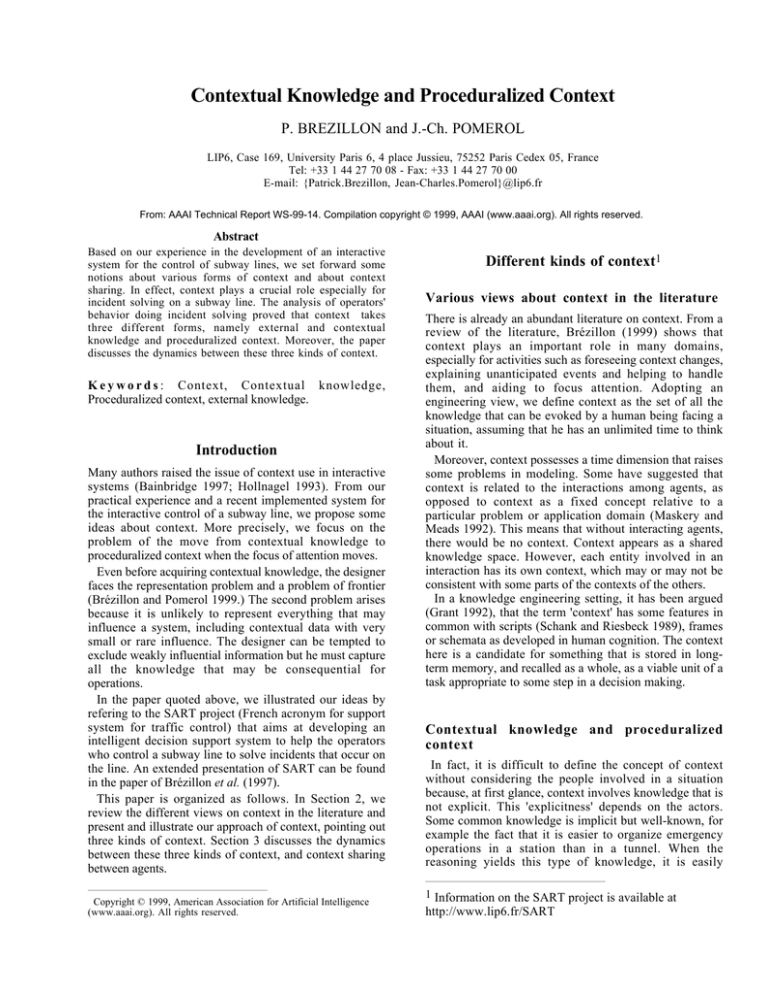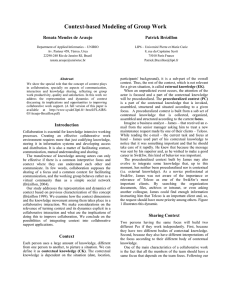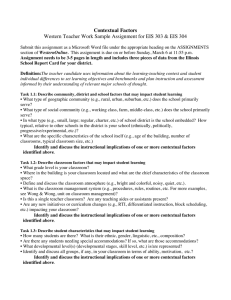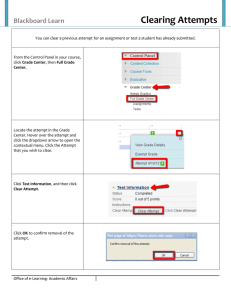
Contextual Knowledge and Proceduralized Context
P. BREZILLON and J.-Ch. POMEROL
LIP6, Case 169, University Paris 6, 4 place Jussieu, 75252 Paris Cedex 05, France
Tel: +33 1 44 27 70 08 - Fax: +33 1 44 27 70 00
E-mail: {Patrick.Brezillon, Jean-Charles.Pomerol}@lip6.fr
From: AAAI Technical Report WS-99-14. Compilation copyright © 1999, AAAI (www.aaai.org). All rights reserved.
Abstract
Based on our experience in the development of an interactive
system for the control of subway lines, we set forward some
notions about various forms of context and about context
sharing. In effect, context plays a crucial role especially for
incident solving on a subway line. The analysis of operators'
behavior doing incident solving proved that context takes
three different forms, namely external and contextual
knowledge and proceduralized context. Moreover, the paper
discusses the dynamics between these three kinds of context.
K e y w o r d s : Context, Contextual knowledge,
Proceduralized context, external knowledge.
Introduction
Many authors raised the issue of context use in interactive
systems (Bainbridge 1997; Hollnagel 1993). From our
practical experience and a recent implemented system for
the interactive control of a subway line, we propose some
ideas about context. More precisely, we focus on the
problem of the move from contextual knowledge to
proceduralized context when the focus of attention moves.
Even before acquiring contextual knowledge, the designer
faces the representation problem and a problem of frontier
(Brézillon and Pomerol 1999.) The second problem arises
because it is unlikely to represent everything that may
influence a system, including contextual data with very
small or rare influence. The designer can be tempted to
exclude weakly influential information but he must capture
all the knowledge that may be consequential for
operations.
In the paper quoted above, we illustrated our ideas by
refering to the SART project (French acronym for support
system for traffic control) that aims at developing an
intelligent decision support system to help the operators
who control a subway line to solve incidents that occur on
the line. An extended presentation of SART can be found
in the paper of Brézillon et al. (1997).
This paper is organized as follows. In Section 2, we
review the different views on context in the literature and
present and illustrate our approach of context, pointing out
three kinds of context. Section 3 discusses the dynamics
between these three kinds of context, and context sharing
between agents.
Copyright © 1999, American Association for Artificial Intelligence
(www.aaai.org). All rights reserved.
Different kinds of context1
Various views about context in the literature
There is already an abundant literature on context. From a
review of the literature, Brézillon (1999) shows that
context plays an important role in many domains,
especially for activities such as foreseeing context changes,
explaining unanticipated events and helping to handle
them, and aiding to focus attention. Adopting an
engineering view, we define context as the set of all the
knowledge that can be evoked by a human being facing a
situation, assuming that he has an unlimited time to think
about it.
Moreover, context possesses a time dimension that raises
some problems in modeling. Some have suggested that
context is related to the interactions among agents, as
opposed to context as a fixed concept relative to a
particular problem or application domain (Maskery and
Meads 1992). This means that without interacting agents,
there would be no context. Context appears as a shared
knowledge space. However, each entity involved in an
interaction has its own context, which may or may not be
consistent with some parts of the contexts of the others.
In a knowledge engineering setting, it has been argued
(Grant 1992), that the term 'context' has some features in
common with scripts (Schank and Riesbeck 1989), frames
or schemata as developed in human cognition. The context
here is a candidate for something that is stored in longterm memory, and recalled as a whole, as a viable unit of a
task appropriate to some step in a decision making.
Contextual knowledge and proceduralized
context
In fact, it is difficult to define the concept of context
without considering the people involved in a situation
because, at first glance, context involves knowledge that is
not explicit. This 'explicitness' depends on the actors.
Some common knowledge is implicit but well-known, for
example the fact that it is easier to organize emergency
operations in a station than in a tunnel. When the
reasoning yields this type of knowledge, it is easily
1 Information on the SART project is available at
http://www.lip6.fr/SART
proceduralized and becomes an implicit part of the
reasoning that can be elicited by knowledge engineers and
finally included in the operation model.
The second fact is that each person involved uses a large
amount of knowledge, different from one person to another,
to picture the situation. We can define the contextual
knowledge as all the knowledge that is relevant and can be
mobilized to understand a given situated decision
problem. By "situated" we mean in given, dated, well
specified circumstances (Clancey 1991). Contextual
knowledge is evoked by situations and events, and loosely
tied to a task or a goal. However, when the task becomes
more precise (e.g., an event occurs), a large part of this
contextual knowledge can be proceduralized according
to the current focus of the decision making. Although the
contextual knowledge exists in theory, it is actually
implicit and latent, and is not usable unless a goal (or an
intention) emerges.
In our definition, contextual knowledge is a sub-part of
the overall context (see Figure 1). Thus, the rest of the
context, which is not relevant for a given situation, is
called external knowledge.
Proceduralized contexts
Focus
(Triggering event)
CONTEXT
external knowledge
contextual knowledge 1
contextual knowledge 2
Figure 1: Different types of context
The proceduralized context is a part of the contextual
knowledge that is invoked, structured and situated
according to a given focus and which is common to the
various people involved in decision making. The
proceduralized context may be compiled but can generally
be elicited with the usual techniques of knowledge
acquisition.
At a given step of a decision making, one has:
proceduralized context that is knowledge commonly
known by the actors of the problem and directly (but
tacitly) used for the problem solving, contextual
knowledge that is knowledge not explicitly used but
influencing the problem solving, and external knowledge
that is knowledge having nothing to do with the current
decision making step, but known by many actors of the
problem.
There are some similar views in the literature. For
example, Anderson's theories (1983, 1993) assume that
knowledge is first acquired in a declarative form which
encodes the basic facts and examples found in the
instructions (our contextual knowledge). Once acquired,
this knowledge is used by general problem-solving rules
to create rules specific to a given context (our
proceduralized context). There is another parallel with the
*global-context* and *local-context* in (Carenini and
Moore 1993). *Global-context* indicates the current topic
under discussion. It contains the place in the dialogue
history where this topic was begun. *Local-context*
points to the most recent utterance. As regards Schank’s
theory, assuming that context is the set of all the possible
stories, the case corresponds approximately to our
proceduralized context while contextual knowledge is the
set of paradigmatic cases.
In the SART application, context is the sum of all the
knowledge, which is known by operators, regarding the
controlling task at large. Contextual knowledge constitutes
the context of the incident solving (and the operator's
decision making). It is composed of all what the opeartor
can learn or be informed in the control room:
- his colleagues that watch the operator and intervene
from time to time by a question or a recall to the
operator,
- information from outside (from the place of the incident
and out of the subway), and
- the visual monitoring and control panel, which is
visible by all operators in the control room, acts as a
kind of shared memory.
At each step of the incident solving (and the operator's
decision making), a part of the contextual knowledge is
proceduralized. For example, at the information "Train too
seriously damaged to be repaired", the piece of contextual
knowledge "the damaged train may be repaired or
evacuated" enters the proceduralized context to become
"Train evacuation." As the incident solving progresses,
new items of contextual knowledge are considered, and,
thus the proceduralized context evolves.
Note that the incident solving is a collective solving of
the incident relying on shared contextual knowledge. This
leads to a kind of decontextualization of the whole process.
Scott (1997) observe the same phenomenon with the
globalization process.
A representation of proceduralized context
Brézillon et al. (1997) discuss of the mandatory procedures
imposed on drivers. Procedures are acquired from
operator's experience during similar incidents and fixed by
the company. An implicit piece of knowledge is that
travelers are safer in a station than in a tunnel. Such a piece
of knowledge, which is not necessarily expressed, result in
more or less proceduralized actions that are compiled as
the proceduralized context (e.g., procedures.) Very often
many pieces of proceduralized context are structured
together in comprehensive knowledge about actions.
However, there is no procedure for complex incidents,
but a set of procedures for solving parts of the incident. For
example, when a train cannot move in a tunnel, there are
procedures for traveler evacuation at the nearest station, to
clear the damaged train by another train, etc. Some
procedures are sequential, but others may be accomplish in
any order compared to some ones. For example, when a
train must push a damaged train, both trains must be
empty but the order in which travelers of the two trains are
evacuated is not important and depends mainly on the
context in which are trains. What is important is that the
two actions must be achieved. As a consequence, there are
as many strategies for solving an incident as operators
because cases that are similar in one context may be totally
dissimilar in others, as already quoted by Tversky (1977).
A representation of contextual knowledge
Contextual knowledge implicitly delimits the resolution
space. It is is always evoked by a task or, in our case, an
event. Contextual knowledge does not focus on a task or
on the achievement of a goal but is mobilized, even
though it has not yet been proceduralized for use.
For instance, in a normal situation, the control operator
faces the following concern:
F0: the 'normal' focus of attention is to see that schedules
and intervals between trains are respected.
This task F0 can be regarded as routine and does not
require special attention. Nevertheless, contextual
knowledge about control is involved:
C0: the normal context associated with F0 involves:
k1: type of day (e.g., working day or weekend),
k2: period of the day (morning, afternoon, evening),
k3: traffic state (rush hours, off-peak hours),
k4: the section load (very busy, few people),
All these pieces of knowledge describe the environment of
the problem with which the following pieces of knowledge
are associated:
k5: the interval between trains according to the situation,
k6: the stopping time in stations, etc.
Assume now that an incident occurs on the subway line;
the pieces of knowledge k1 to k4 are (or should be)
immediately invoked. This results in k5 and k6 being
invoked too. All these pieces of contextual knowledge
become a part of the proceduralized context in which the
incident is resolved; contextual knowledge appears backstage, whereas the proceduralized context is front-stage in
the spotlights. It is noteworthy that, as far as engineering
is concerned, only the proceduralized context matters, but
contextual knowledge is necessary because this is the raw
material from which proceduralized context is made.
Turner (1998) develops some similar ideas for the
context-sensitive reasoning of underwater vehicles. Context
is mainly considered as a way to cluster knowledge for
efficiency search, for representing counter-factual or
hypothetical situations, for circumscribing the effects of
particular actions to particular situations, and for directing
an agent's focus of attention to salient features of a
situation.
Move between proceduralized context,
contextual and external knowledge
We think that it is not only important to understand the
dynamics of planning and action but also the dynamics of
knowledge management. This is a twofold phenomenon
that consists of focusing on some stimuli and, on moving
contextual information from back-stage to front-stage.
Interaction between agents appears to be a privileged way
for moving a contextual knowledge into and out of the
proceduralized context.
A Dynamics of the proceduralized context
At the interaction level, making context explicit enables
knowledge to be shared with others. For example, in the
case of "Sick traveler in a train," the change from the step
"Answer the alarm signal" to "Stop at the next station"
was surprising to us (as knowledge engineers). The
triggering of the alarm signal implied for many years an
immediate stop of the train, even in a tunnel because an
alarm signal needed immediate attention. To explain the
skipping of the action "Answer the alarm signal", the
operator said that, based on company experience, they have
decided to stop only at the next station for several reasons.
Some reasons are easy to understand (e.g., rescue is easier
in a station than in a tunnel). Other reasons needed
additional knowledge (e.g., a traveler may be sensible to
claustrophobia in a tunnel). Once we were able to gather
all these reasons into a coherent picture, we understood the
change.
Figure 2 represents how the proceduralized context is built
from contextual knowledge during an interaction between
two agents. The interaction context contains
proceduralized pieces of knowledge in the focus of attention
of the two agents. These pieces of knowledge are extracted
from the contextual knowledge of each agent; they are
structured jointly by both agents and result in a shared
knowledge. Generally, the first utterance of an agent gives
a rule such as 'Stop at the next station' if the alarm signal
is triggered. Then on the request of the second agent, the
first agent may add some pieces of knowledge related to
his first utterance. If this knowledge chunk belongs to the
common part of the contextual knowledge of the agents,
the pieces are integrated into a mutually acceptable
knowledge structure, and the knowledge structure may
then be moved to the shared proceduralized context.
Thus, the proceduralized context contains all the pieces
of knowledge that have been discussed and accepted (at
least made compatible) by all the agents, and these pieces
of proceduralized context then become part of the
contextual knowledge of each agent. Even if they do not
remain within the focus of the proceduralized context, they
may be recalled later as a whole because shared. For
example, "Stop at the next station" is such an example in
the solving of "Sick traveler in a train."
Contextual
knowledge 1
Shared
contextual
knowledge
Contextual
knowledge 2
Proceduralized
context
resulting from
interaction
compilation, originated from experience, of several actions.
In this compilation, a part of the knowledge on each action
becomes implicit in the proceduralized context.
Without entering the details, macro-actions are a way to
proceduralize contextual knowledge and to introduce
modularity in the diagnosis process by managing different
modules accomplishing the same function in different ways
according to the context. However, action postponement is
not always possible, and it is preferable to look for pruning
the decision tree in some situations (Brézillon, Pomerol
and Saker 1998).
As said previously, RATP (the French metro company)
has established procedures for incident solving on the basis
of their experience. However, each operator develops his
own practice to solve an incident, and one observes almost
as many practices as operators for a given procedure
because each operator tailors the procedure in order to take
into account the current proceduralized context, which is
particular and specific. This is observed in a number of
companies it is a way of getting the result whatever the
path followed. The validation of such unwritten rules is
linked more to the result than to the procedure to reach it.
Figure 2: A representation of the interaction context
Dynamics of the decision making process and
its contextual dependency
Operators solve an incident by choosing a scenario,
which is a sequence of actions conditional on possible
events. The choice of a scenario greatly relies on
contextual knowledge. One operator said us: "When an
incident is announced, I first look at the context in which
the incident occurs." The reason is that operators want to
have a clear idea of future events; the purpose of this lookahead reasoning (Pomerol 1997) is to reduce, as far as
possible, the uncertainty in the scenario. The problem for
operators is that many scenarios are similar at the
beginning and then diverge according to the context.
Thus, a scenario is a sequence of actions intertwined with
events that do not depend on the decision makers but that
result in a limitation of their actions. For instance:
Focus of attention:
Removal of a damaged train from the line.
Contextual information: Level of activity on the line.
Action: Lead the damaged train:
- to the terminal if the line activity is low
- to the nearest secondary line if line activity is high.
As most of the contextual elements may intervene in
several scenarios (e.g., traffic activity, position of the next
train), operators prefer to take them into account as soon as
possible to get a general picture of the best path to choose.
At this step, contextual knowledge is proceduralized and
in the meantime operators postpone action. The main
objective is to eliminate event nodes. By grouping
together a set of actions in a macro-action, operators hope
to make the following step easier. An example is given in
(Brézillon and Pomerol 1998.) Macro-actions are a kind of
Conclusion
In this paper, we introduced three types of context by
refering to the SART application for the subway control,
we mainly focused on the decision making process during
incident solving. We considered three parts in context,
namely external and contextual knowledge, and
proceduralized context. External knowledge is the part of
context that has nothing to do with the incident solving at
a given step of the incident solving. Contextual knowledge
is knowledge that does not interven directly in the
decision making process but constrains it. Procedurelized
knowledge is a part of contextual knowledge that is
structured to be used at a given step of the decision
making.
Another result that we discussed in the paper is the
dynamic among these three part of context when the
decision making progresses from one step to the following
one. Some pieces of proceduralized leave the interaction
context to become shared contextual knowledge. Other
pieces of contextual knowledge (and eventually from the
external knowledge) enter the proceduralized context.
These two aspects, static description of context and the
dynamic of context are modeled in our application at the
level of the domain knowledge and included in the
reasoning for incident solving.
We definitely believe that one cannot apprehend
contextual issues in a static framework and that expliciting
and sharing of contextual knowledge is key process for
addressing and understanding context problem.
Acknowledgments: The SART project enters a convention
between two universities, the University Paris 6 (France)
and the Federal University of Rio de Janeiro (FURJ,
Brazil), a contract between the University Paris 6 the
company of the subway in Paris (RATP), and another
contract between the FURJ and Metrô that manages the
subway in Rio de Janeiro. Grants are provided by
COFECUB in France and CAPES in Brazil. We also thank
J.-M. Sieur at RATP, and C. Gentile, L. Pasquier, I. Saker
and M. Secron, Ph.D. students working in the SART
project.
References
Anderson, J. R. 1983. The architecture of cognition.
Cambridge, MA: Harvard University Press.
Anderson, J. R. 1993. Rules of the Mind. Hillsdale, NJ:
Erlbaum
Bainbridge, L. 1997. The change in concepts needed to
account for human behavior in complex dynamic tasks.
IEEE transactions on Systems, Man and Cybernetics, 27,
3, 351-359.
Brézillon, P. 1999. Context in human-machine problem
solving: A survey. Knowledge Engineering Review, to
appear.
Brézillon, P., and Pomerol, J.-Ch. 1998. Using contextual
information in decision making. In: Chapman & Hall.
Widmeyer G., Berkeley D., Brezillon P. & Rajkovic V.
Eds.: Context-Sensitive Decision Support Systems, pp.
158-173.
Brézillon, P., and Pomerol, J.-Ch. 1999. Contextual
knowledge sharing and cooperation in intelligent assistant
systems. Le Travail Humain (to appear).
Brézillon, P.; Gentile, C.; Saker, I.; and Secron, M. 1997.
SART: A system for supporting operators with contextual
knowledge. Paper presented at the International and
Interdisciplinary Conference on Modeling and Using
Context (CONTEXT-97). Rio de Janeiro, Brasil, Feb.
Brézillon , P.; Pomerol, J.-Ch.; and Saker, I. 1998.
Contextual and contextualized knowledge and application
in subway control. International Journal of HumanComputer Studies, 98, 357-373.
Carenini, G., and Moore, J. D. 1993. Generating
explanations in context. International Workshop on
Intelligent User Interfaces, Orlando, Florida.
Clancey, W.J. 1991. Bookreview of Israel Rosenfeld, The
invention of memory : a new view of the brain. Artificial
Intelligence, 50, 241-284.
Grant, A.S. 1992. Mental models and everyday activities.
nd
Paper presented at the 2 Interdisciplinary Workshop on
Mental Models, Cambridge, UK, March, 94-102.
Hollnagel, E. ed. 1993. Human Reliability Analysis,
Context and Control. London: Academic Press.
Maskery, H., and Meads, J. 1992. Context: In the eyes of
users and in computer systems. SIGCHI Bulletin, 24, 2,
12-21.
Pomerol, J.-Ch. 1997. Artificial Intelligence and Human
Decision Making. European Journal of Operational
Research, 99, 3-25.
Schank, R.C., and Riesbeck, C.K. eds. 1989. Inside casebased reasoning. Lawrence Erlbaum Associates, chap. 1-2.
Scott, C. 1997. The Proceduralization of Telecommunications Law: Adapting to Convergence. Work In Progress,
1997 (3), The Journal of Information, Law and
Technology, JILT. <http://jilt.law.strath.ac.uk/jilt/wip/
97_3scot/scott.TXT>
Turner, R.M. 1998. Context-mediated behavior for
intelligent agent. International Journal of HumanComputer Studies, Special issue on Using Context in
Applications, 48(3): 307--330.
Tversky, A. 1977. Features of similarity, Psychological
Review 84(4): 327--352.






